► We drive the last ever petrol-powered Lotus
► Emira offers stunning handling and supercar styling
► Four-cylinder model is a bit of a let-down, though
Has Lotus saved its best sports car for last? This is the Emira – Hethel’s final hurrah for combustion power before it dons its eco trousers and starts pedalling electric cars. And, as the successor to the rather excellent Elise, it has quite the reputation to live up to.
Like its predecessor, we expect it to handle well (spoiler alert – it does). But we’re concerned about whether Lotus has managed to rectify the issues that have always plagued its cars. Namely, can it compare to its biggest rivals – the Porsche 718 Cayman and Alpine A110 – in terms of build quality and practicality?
So, is this just another plucky Lotus – or is it a true contender for the sports car crown? Our Lotus Emira review has all the answers you need, and you can even see how it compares directly with its key rivals in the video above.
Start with the important stuff. How are the engines?
We’ve now sampled both versions of the Emira and, we’re sorry to say, they haven’t been created equal. The cheapest model features a Mercedes-AMG-sourced 2.0-litre four-cylinder unit with 355bhp and 317lb ft of torque. Above that, there’s a Toyota-derived 3.5-litre V6 with 394bhp and 310lb ft of torque.
There isn’t much separating the two cars on paper. The four-cylinder model is lighter than the V6 and it has slightly more torque, which means it can sprint from 0–62mph in 4.3 seconds. That’s only 0.1 seconds behind the fastest V6. The two cars’ top speeds are close, too – 171mph for the 2.0-litre and 180mph for the 3.5-litre. So, what’s the problem?

Well, you can only have the four-cylinder engine with an automatic gearbox – and it’s atrocious. It’s incredibly dim-witted, even in Sport or Track mode, which makes it difficult to neatly string together a set of corners. The software is constantly fighting you, preventing you from down shifting when you’re approaching a corner, even when you know there’s no danger of blasting the valves through the engine cover. It delays your upshifts when you hit a straight, too.
Happily, the engine has a bit of character. It’s slightly clattery at low speeds but, once you’re in the upper two-thirds of the rev-counter, it sings. Plus, it has the most vocal turbocharger we’ve ever experienced on a production car. Every time you take your foot off the throttle, it whistles and chirps like songbird. It’s hilarious fun when pottering around town.
What about the V6 model? Surely that’s better?
Oh yes. Much better. It sounds great and the manual gearbox adds an extra dash of engagement. It’s the same transmission that was fitted to the Evora and Exige, though, which means you must be patient with it. The clutch is heavy by modern standards, too, and the action tends to be obstinate. However, that means the satisfaction of getting a shift right – up or down – is immense.
That theme of immense satisfaction carries throughout the car. Direction changes? Instantaneous and incredibly gratifying. There’s roll but, like the best sports cars, it’s always controlled – and the movement helps you feel what’s going on. It’s an aid to getting your bearings rather than an impediment. Steering? Still hydraulically assisted and loaded with feedback. And, while the Emira is available with various ADAS including lane assist, it isn’t available with self-steering lane-keeping. When a car steers this well, you want to have it all to yourself.
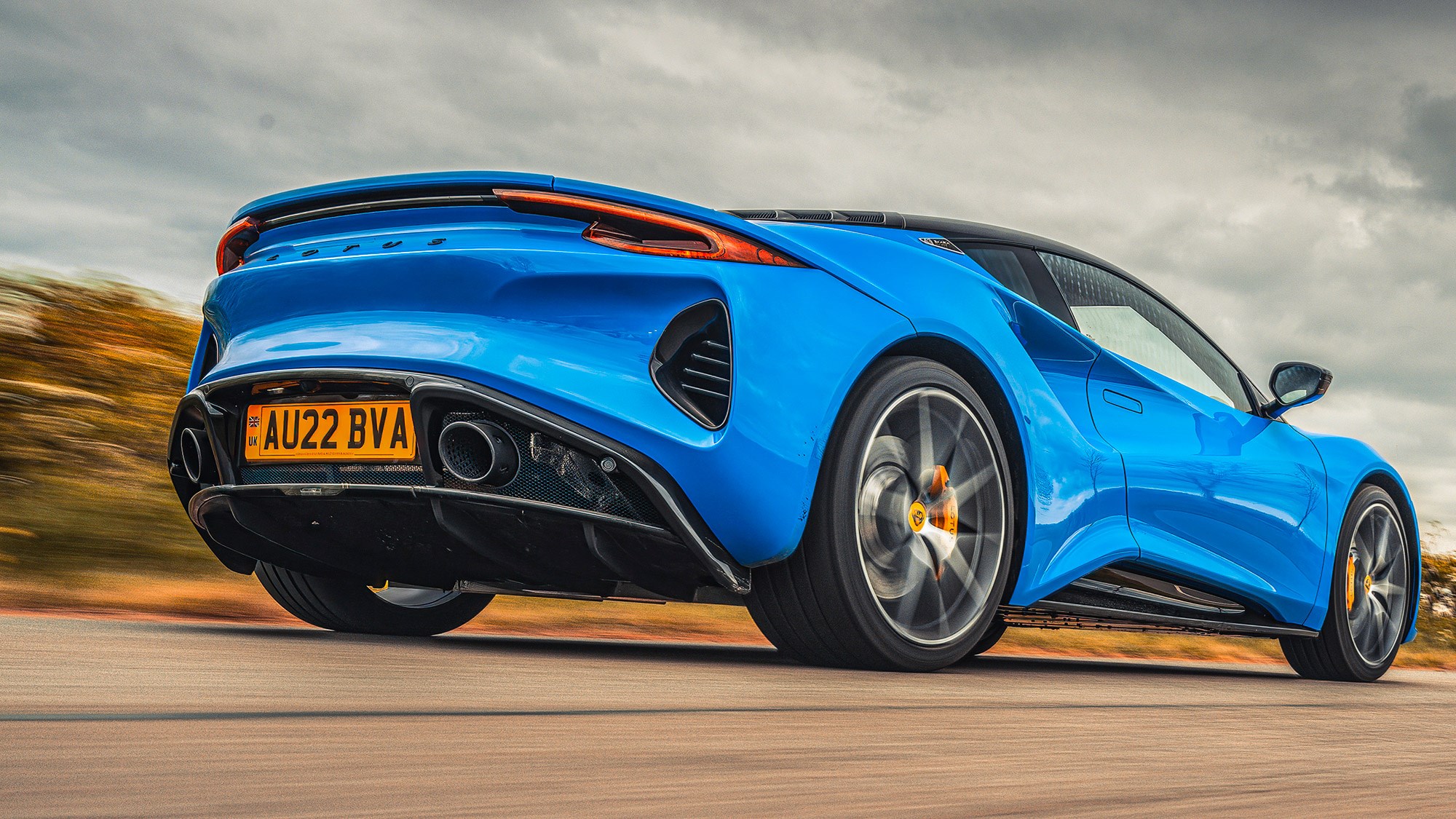
However, while the Emira steers fantastically when compared to its peers, to us, it doesn’t feel quite as communicative as an Evora. It’s still lovely and beautifully linear – and there’s enough definition to detect the joints in the tarmac in detail. The view out of the windscreen is great, too. The Emira’s low nose vanishes out of your sightline, leaving only the twin humps of the front wheel arches. What’s even better is that their high points are directly over the front tyres’ centre lines, which means you haven’t got an excuse for missing an apex.
Neat segue, there. So, what’s it like in the corners?
Fabulously grippy, no matter what drive mode you’re in. The Emira’s Track setting is designed to work with Michelin Cup 2s but, for weather-related reasons, we’ve sampled the car on its standard, bespoke-compound Goodyear rubber. Don’t fret, though – the Emira can still pull 1.2G on the Goodyears, so its limits are almost unassailably high in regular driving. Despite this, you always feel connected to the car – it doesn’t feel numb or uninvolving the way some intensely grippy cars do.
The middling Sport setup is firm for the road, there’s no getting away from that. However, it’s only annoying at particularly low speeds. Once you’re moving even a little faster, the Emira starts to work with the surface rather than against it, and you quickly forget the foibles in favour of the dynamics. They’re pin sharp and finely balanced – it feels out of the ordinary. Exotic. But also, on your side and exhilarating, rather than intimidating.
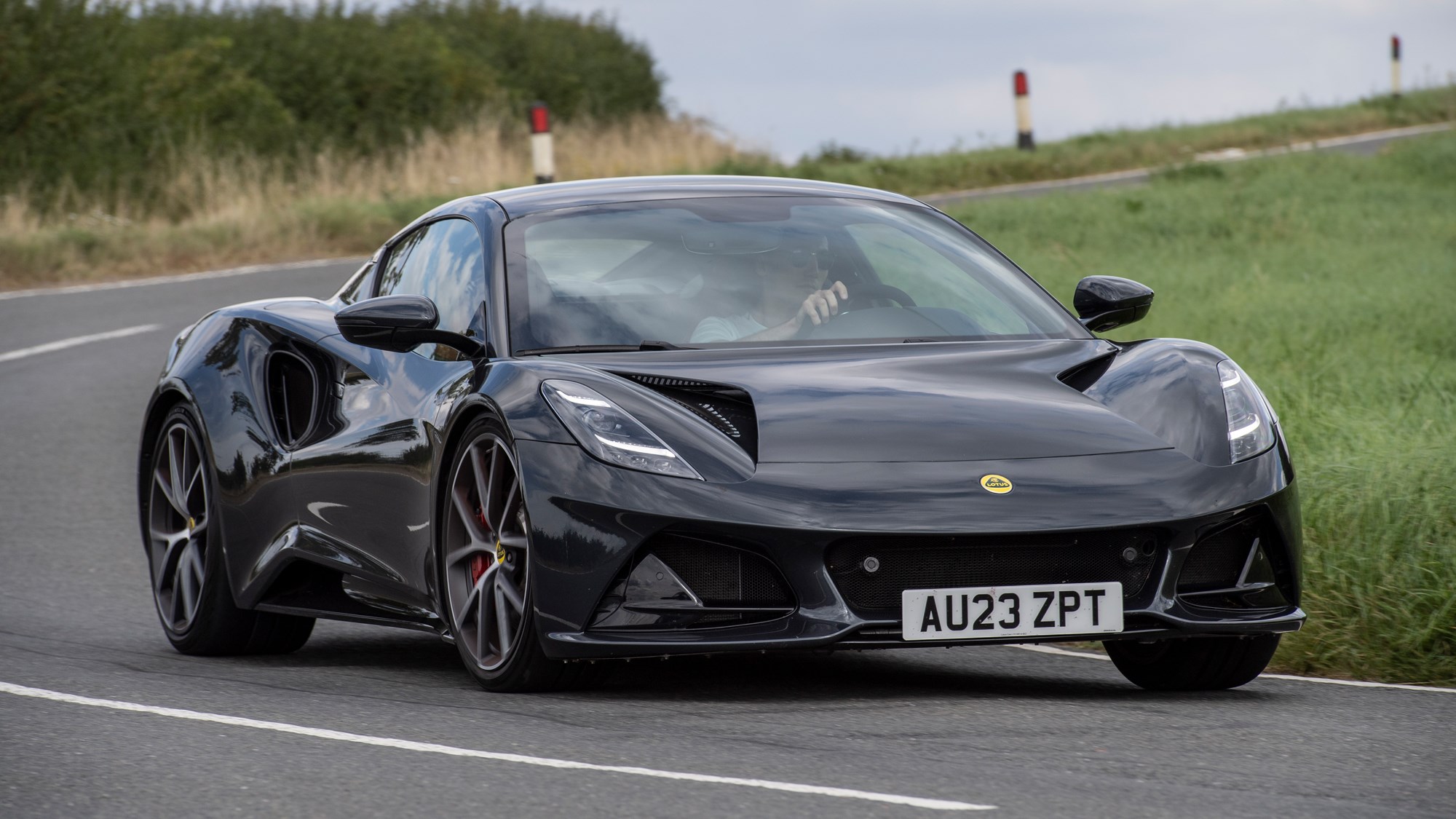
You can blast down B-roads that would batter a Ferrari 296 GTB’s underside to a pulp, and the Emira will take it all in its stride. As a daily, the softer Tour setup is surely the better bet. We could live with Sport mode, though, and as a weekend car the upgrade could be worth the minor compromise for the increased sense of purpose and ultimate capability.
Is the Lotus Emira fast?
Is it fast. Look at it.
It builds speed quickly. Effortlessly. Even if you leave it in third for the hairpins, you’re quickly travelling at three-figure speeds down the following straight. But it’s the way the Emira loses speed that really raises your heart rate. You have massive, confidence-inspiring braking power with plenty of pedal feel – something that’s important on both road and track. In terms of stability, it’s well ahead of the already superb Evora; you can jump on the brakes as hard as you like while relaxing your grip on the steering wheel and it tracks straight and true.
The V6 feels and sounds a little truculent at first. You can see it lurking in the rear-view mirror, and it makes its presence felt mechanically rather than through charisma at lower rpm. Cruising refinement is fine for something with this kind of performance.
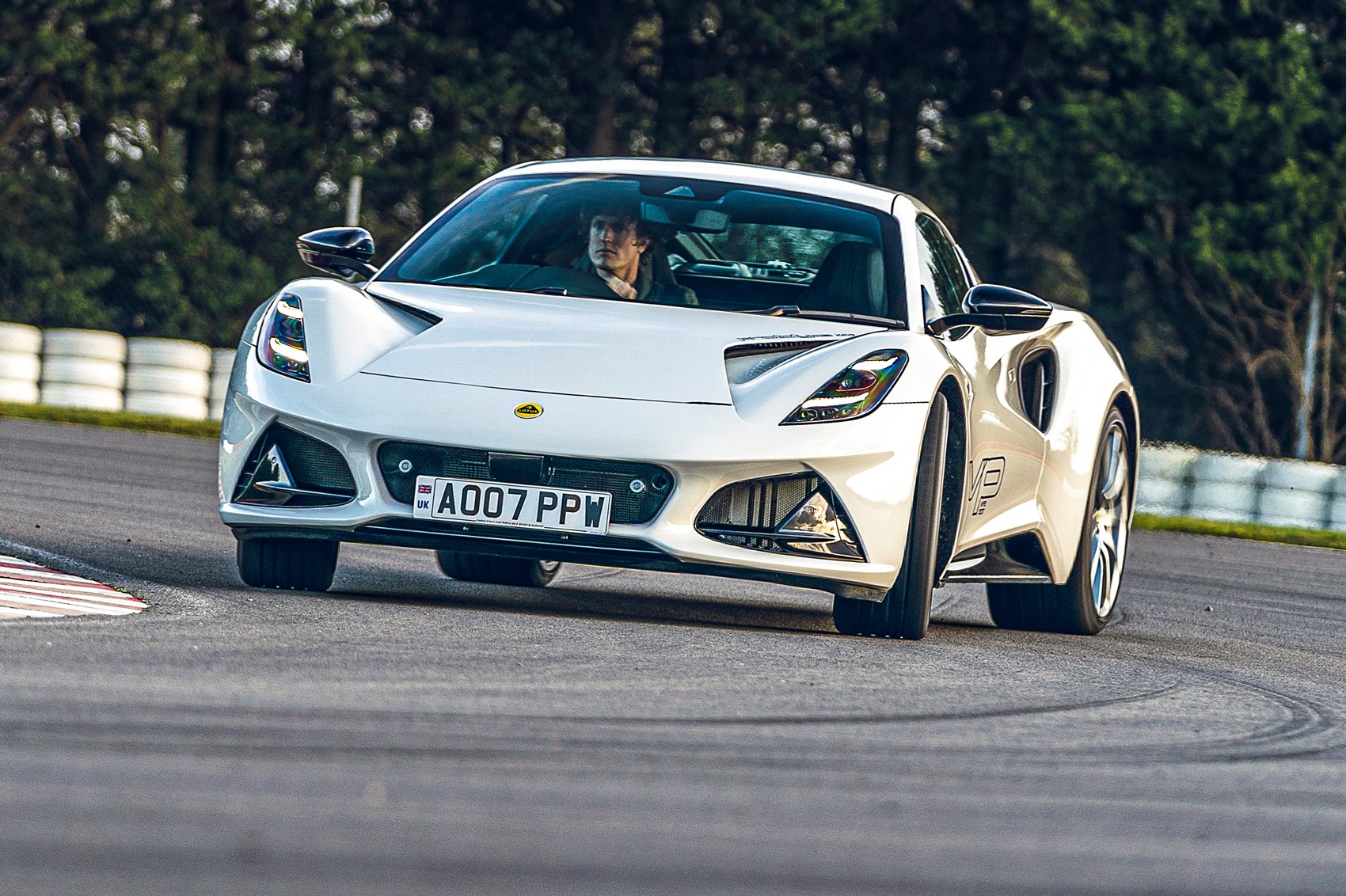
It takes a fair amount of familiarity and commitment before you find yourself fully winding it up on the road. When you do, however, the reward is not only a serious amount shove – which the chassis sublimely shoulders through the corners – but an evocative banshee wail reminiscent of an earlier era of F1 car, a ping as much as a zing when it passes in the opposing direction at maximum attack.
It’s not as beefy, perhaps, as the big flat-sixes Porsche has returned to for its most muscular Caymans, but it’s certainly faster than even the mightiest A110. Even the four-pot Emira would make the Alpine look like it was going backwards but, considering the difference between the two engines is only a few thousand pounds, we reckon you should just have the V6. It’s a little more special – and where the Emira excels is in that sense of excitement beyond the conventional.
How does the Emira’s cabin compare to its predecessor and its rivals?
It’s easier to get in and out of the Emira than with previous Lotus sports cars. Its thick sill means it’s not quite as straightforward as ducking into a Cayman or A110, but it’s certainly less demanding than clambering into an Evora. It’s also far easier than an Elise or Exige, which demanded a game of roadside Twister on entry and egress. The trickiest thing for the Emira, if you have long legs, is not putting a footprint on the joint between the dash and the sill as you lift your trailing foot in.
You sit low in the Lotus Emira, although perhaps not quite as low as you’d expect. The seating position is a little too high if you’re tall, which means you can feel perched atop the chassis rather than plugged into it.
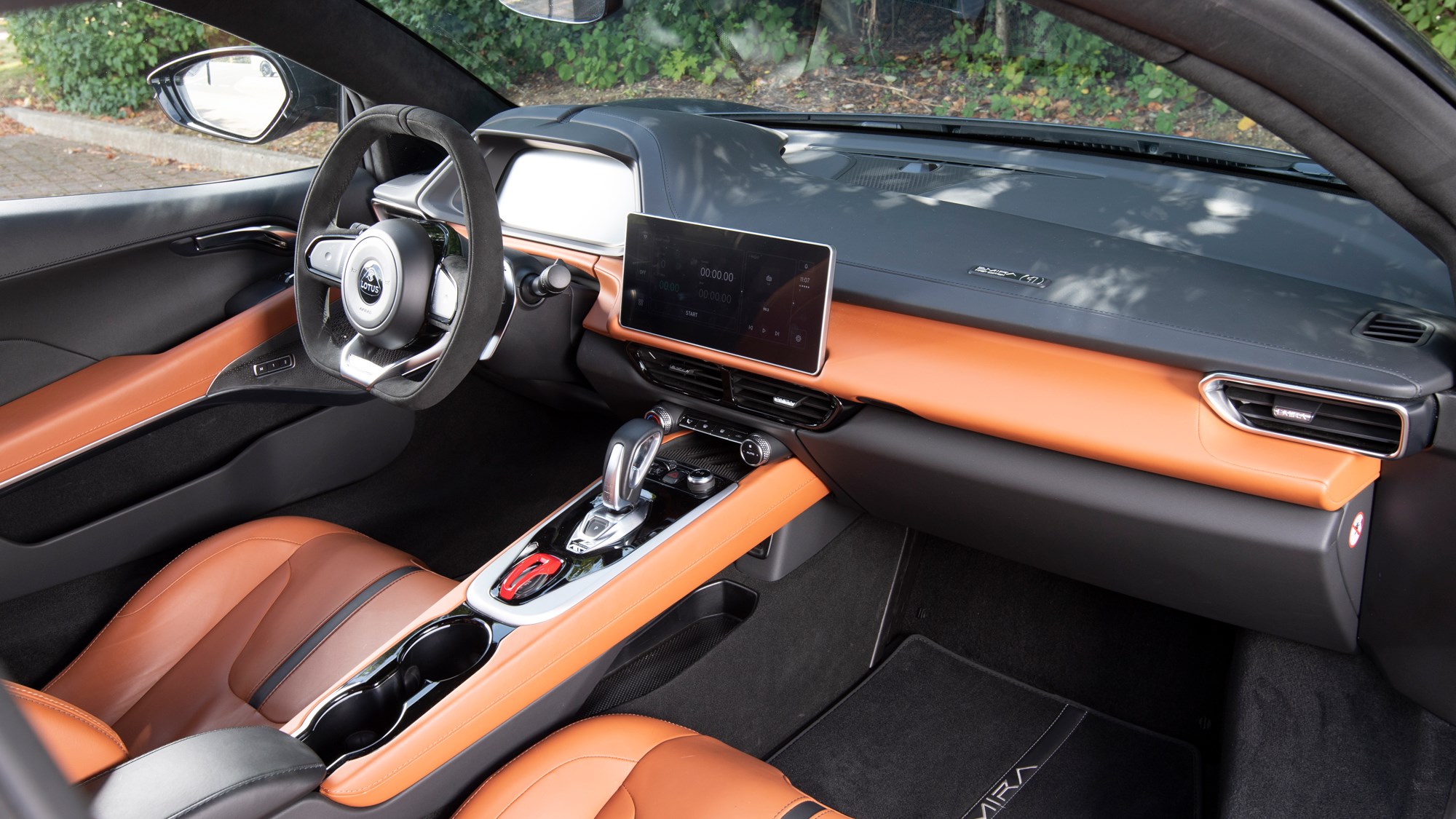
Ahead are two digital screens – one for the instrument panel, which chameleons between displays in the three driving modes (Tour, Sport and Track) and a touchscreen in the centre of the dash. Graphics on both screens are clean, minimal, modern. Very Lotus.
But the software powering the screens is clunky. You need to prod the drive mode switch several times before the car will allow you to switch between settings – and swapping between the navigation and climate control menus on the infotainment screen is agonising slow.

Lotus hasn’t squished all the Emira’s controls onto the touchscreen, though. The functions are split between proper buttons and touch controls – and, praise be, Hethel’s engineers fitted proper air-con and audio dials, which means you can operate them without taking your eyes off the road.
Keep digging and you’ll find the Geely influence in the cabin. The automatic gear selector works in the same way as Volvo’s petrol-powered cars, moving right and left to shift gears up and down. The touch-sensitive steering wheel controls have the same layout as Volvo and Polestar’s cars, too. They’re a bit too sensitive for our liking, though – you can activate them accidentally when cornering, which will swap the menus on the digital gauge cluster.
It’s a sports car, so it’s bound to be cramped inside. Right?
Wrong. It’s surprisingly spacious and it’s fitted with some thoughtful storage solutions. There’s a deep storage fissure is built into the centre console under the armrest, and there’s space for a smartphone ahead of the gear lever (or you can drop it into the dog bone-shaped cupholders).
Plus, because the Emira only has two seats, there’s a handy storage shelf behind the rear seats – and you even get a reasonable boot behind the engine. Just don’t use it to store anything perishable. It gets quite hot, being so close to the engine. The cab-forward design together with aero, cooling and crash structure demands ahead of the driver are the reason there’s no front boot.
It’s all very grown-up. It’s less striking than the all-aluminium environs of an Elise – less of a sports-car cockpit, more of a coupe cabin – but that’s not a problem. If it’s a touch less evocative than an Elise, it’s about 500 per cent more practical and we’d much rather face a long journey in an Emira than an Evora.
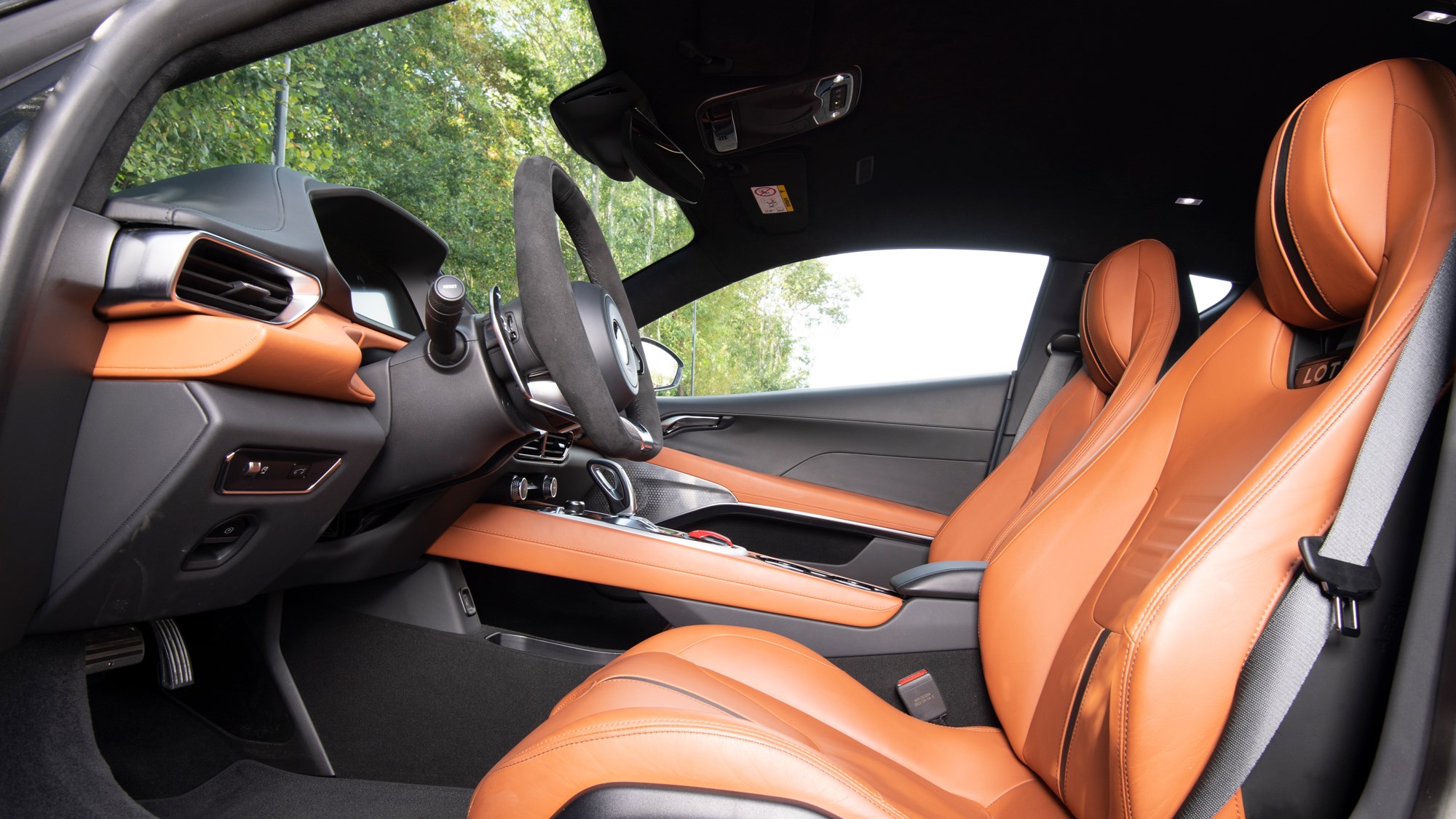
Quality is generally pretty good. The upholstery and trim feels very expensive, although some of switchgear is a little cheap. The little red plastic cover over the start button is flimsy, for example, and the paddle shifters on automatic cars are too lightweight. We wish they had the same weight as the Alfa Romeo Giulia’s glorious metal paddles. In summary, it’s less plasticky inside than an Alpine A110, but not quite up to that cliched bank-vault standard of the Porsche Cayman.
Lotus Emira: the verdict
The Emira is a giant leap forward for Lotus in so many areas. The interior is so much better than its predecessors, the styling is outstanding and it’s easier to use right down to its surprisingly friendly all-round visibility. No, it isn’t as practical as a Cayman or as instantly thrashable as an A110, but the gap has been closed an enormous extent.
It isn’t perfect. The automatic gearbox yoked to the four-pot is denser than a Bulldog and about as athletic. The infotainment software is glacially slow, too – and you need to make sure you’ve had your Weetabix before setting off for a drive in the manual model. But what you get in exchange for these minor compromises is a machine that doesn’t so much seem like a competitor in the regular mid-engined sports car category, as it does a supercar that’s slumming it.
If you need an everyday accessory, take the Cayman. If you value lightness of being above all else, try the Alpine. But if you want weekend wheels with wow factor and an intricate, immersive, involving experience, then you should take a very close look at the Emira. Just don’t buy the 2.0-litre. The V6 manual is the one to go for.
See the new Lotus in action in our video at the top of this page.